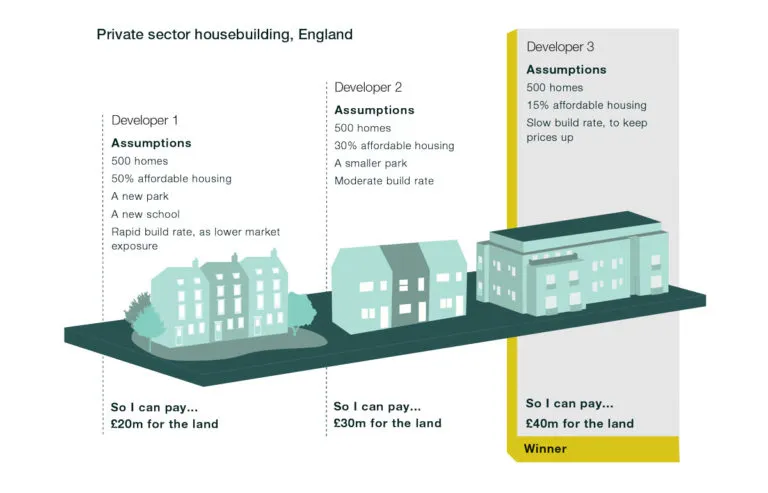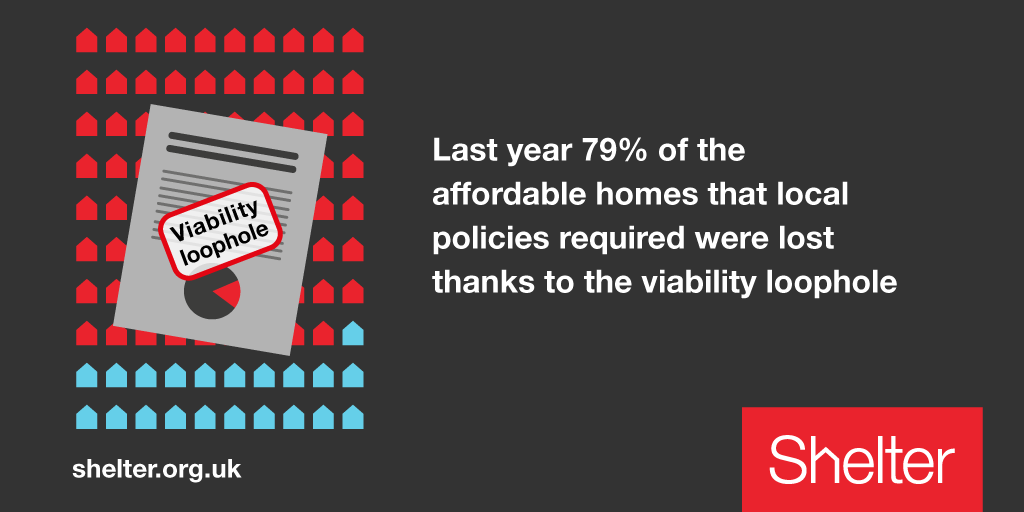The high cost of viability assessments: 2,500 affordable homes lost in just one year
Published: by Rose Grayston
Over the last year, we’ve blogged many times about viability assessments, their role in cutting affordable homes, and the lack of transparency around how developers use them.
New research from Shelter shines a light on just how much damage this legal loophole is doing. Eleven councils covering nine English cities lost 2,500 affordable homes in just one year on schemes where developers used viability assessments. That’s equivalent to a 79% cut in desperately needed affordable homes to rent or buy.
It’s essential that the government follows through on plans to shut down this legal loophole and turn affordable housing policies into cast iron pledges. Here’s why.
What is viability?
http://blog.shelter.org.uk/wp-content/uploads/2017/11/OBR-2048_NCH_Viability_animation-FINAL.mp4
Viability assessments are financial appraisals of the amount of profit a developer can expect to make on a scheme. If expected profits are below 20%, the number of affordable homes the developer is required to build under Section 106 agreements can be knocked down, according to the government’s planning rules. The same is true for transport and infrastructure, quality design, the sizes of new homes – or anything else the local community might have expected from the development. They all get squeezed by viability assessments.
This viability loophole provides a safety net for developers, who can overpay for land to guarantee they win sites, safe in the knowledge they will be able to argue down community benefits to make their money back later. In this way, the current system rewards developers who overpay for land and works against those who try to pay the right price for land to deliver affordable housing policies. As a result, land prices have shot up, while communities have lost out on thousands of affordable homes every year since the loophole was introduced in 2012.

The role of viability assessments in pushing down affordable housing delivery is well known throughout the planning and housebuilding industries. However, the scale and geographical spread of the problem has remained largely hidden until now.
To address this evidence gap, Shelter has undertaken research across eleven local authorities, covering nine of England’s biggest cities, to reveal the impact of viability assessments in urban areas across the country in 2015–16. The findings – featured on Newsnight last night (28:30) and detailed in our report out today – are damning.
Developers have successfully slashed affordable housing numbers using viability assessments
Where viability assessments were used, new housing sites achieved just 7% affordable housing. This is far below the affordable housing policies of the local authorities in this study, which on average require that 28% of new homes built should be affordable homes.
This amounts to 2,500 affordable homes lost in just one year on schemes where developers submitted viability assessments, equivalent to a 79% reduction in affordable housing compared to the levels required by council policies. This is happening in some of the country’s least affordable areas, where these homes are most needed.

Viability assessments have become the norm
Viability assessments were used to negotiate down affordable housing provision on 44% of new developments in the study, rising as high as 77% in Kensington and Chelsea.
We are missing out on affordable homes all over the country because of viability assessments
So far, there has been more research into the role of viability assessments in reducing affordable housing numbers in London than elsewhere. But this study reveals drastic reductions in cities all over England. In just one year, sites where developers submitted viability assessments saw:
- 1,003 affordable homes lost in Birmingham
- 472 affordable homes lost in Manchester
- 338 affordable homes lost in Leeds
- 196 affordable homes lost in Bristol
Won’t closing the viability loophole make it harder to build homes?
The benefits of closing the viability loophole for affordable housing are obvious. But it would also bring broader benefits. The decision to relax planning obligations through viability was taken to boost sluggish markets for land and housing following the last recession, with the aim of driving up overall supply. In fact, organisations like the Chartered Institute of Housing have pointed out that viability assessments are now hampering overall supply, by exacerbating an over-reliance on a small number of developers and contributing to a lack of diversity in housing output.
A housebuilding system which is over-dependent on housing for private sale to make up overall numbers will find itself unduly constrained by natural limits to demand. Developers can only build homes for sale as fast as they can sell them – and there is only so much money chasing homes for sale. That’s why private development on its own has never come close to delivering the 250,000+ homes a year we need to keep up with demand.
By contrast, there is a guaranteed and instant market for affordable homes for rent, helping to de-risk development and getting sales receipts in quickly. Research from planning consultants Lichfields shows that large sites delivering 30%+ affordable housing have build out rates 40% higher than those of large sites delivering only 10-19% affordable housing.
This should not surprise us. When developers have certainty about the number of affordable homes to build, this will be part of the normal cost of doing business. They will no longer need to overpay for land to stay competitive in the first place. Developers playing by these new rules will still be able to make good returns, while providing their share of the affordable homes the country desperately needs.
What next?
We now have an opportunity to close the viability loophole for good. The government is gathering views on the future of viability assessments in its ‘Planning for the right homes in the right places‘ consultation, which closes next week, and has made clear its intention to scrap the current rules around viability assessments. Shelter’s new research should be the final nail in the coffin for this legal loophole. Instead, we can create a system that is limited, fair and transparent:
Recommendation 1: Strengthen Local Plans – so they make it absolutely clear what local communities expect to get from development
Recommendation 2: Limit the use of site-level viability assessments to a strictly-defined set of exceptional circumstances – so the Local Plan policies (like affordable housing) are the default, not something to be routinely negotiated away
Recommendation 3: Incentivise policy-compliant schemes – by fast-tracking them through the planning process
Recommendation 4: Redefine and clearly justify the level of returns to be supported by the planning system – so that developer returns are more appropriate to the level of risk they are taking
Recommendation 5: Where site-level viability assessments are used, make all evidence fully transparent – so that local communities can scrutinise the numbers and hold developers and councils to account
For full findings from the research and more on how to close the viability loophole, read our report.